How Primary School Curriculums in 11 Countries around the World Deliver Food Education and Address Food Literacy: A Policy Analysis
Abstract
1. Introduction
1.1. Food Education Policy Literature
1.2. Food Education Literature
1.3. Food Literacy
the ability of an individual to understand food in a way that they develop a positive relationship with it, including food skills and practices across the lifespan in order to navigate, engage, and participate within a complex food system. It‘s the ability to make decisions to support the achievement of personal health and a sustainable food system considering environmental, social, economic, cultural, and political components.
1.4. Study Purpose
- select and develop a framework to analyse how well each country addresses FL.
- analyse primary education curriculums that include food education from different countries, using the framework.
- identify insights from primary education curriculums in other countries to improve food education policy.
2. Materials and Methods
2.1. Policy Content Analysis
2.2. Framework Development and Scoring
- Understanding different life stages (e.g., food needs of babies, children, and elderly).
- Understanding current healthy eating guidelines and can apply them to their own diet
- Understanding how to grow food in a garden.
- Understanding the role of the senses in eating.
- Understanding the FS.
- Understanding the role of politics and economics in the FS.
2.3. Curriculum Content Analysis
2.4. Data Analysis
3. Results
3.1. General Features of Food Education in 11 Countries
3.2. Food Curriculums
3.3. Non-Food Curriculums
3.4. How Curriculums Address FL Together
3.5. Impact of Policy Detail and Language on FL
4. Discussion
4.1. Food Education Findings
4.1.1. All Countries Have a Dedicated Food Education Curriculum Where Food Is a Core Topic, but There Is No Standardised Approach to Topics Included in Food Education
4.1.2. There Is No Consensus in Primary Food Education Nomenclature and What Curriculums Constitute
4.1.3. Non-Food Curriculums Include Food Education
4.1.4. Food Curriculums Focus on Knowledge and Lack Practical Skills Development
4.2. Food Literacy Findings
4.2.1. Curriculums Predominantly Focus on Confidence and Empowerment with Food (Theme 1) and Significantly Less on Social-Cultural, Equity and Sustainability Themes (Themes 2 and 3)
4.2.2. Primary Curriculums Rarely Deal with FL Comprehensively but Have Potential to
4.2.3. Food Literacy Is Most Comprehensive When Delivered through a Single Food Curriculum, Complemented by Non-Food Curriculums
4.3. Impact of Policy Approach on FL
4.4. Study Limitations
5. Conclusions
Author Contributions
Funding
Institutional Review Board Statement
Informed Consent Statement
Data Availability Statement
Acknowledgments
Conflicts of Interest
Appendix A
| Subtopic Search Terms | Total Papers | Number of Applicable Papers in First 50 Results |
|---|---|---|
| “Nutrition Education” + “primary school or primary education or elementary education” | 739 | 50 |
| “Cooking” + “primary school or primary education or elementary education” | 524 | 22 |
| “Home Economics” + “primary school or primary education or elementary education” | 474 | 5 |
| “Healthy Eating” + “primary school or primary education or elementary education” | 426 | 21 |
| “Sustainability” + “primary school or primary education or elementary education” | 355 | 19 |
| “Growing” or “Gardening” + “primary school or primary education or elementary education” | 115 | 27 |
| “Food Technology” + “primary school or primary education or elementary education” | 53 | 3 |
| Food Education” + “primary school or primary education or elementary education” | 20 | 10 |
| “Food Literacy” + “primary school or primary education or elementary education” | 15 | 5 |
| “Sensory Education” + “primary school or primary education or elementary education” | 6 | 4 |
Appendix B
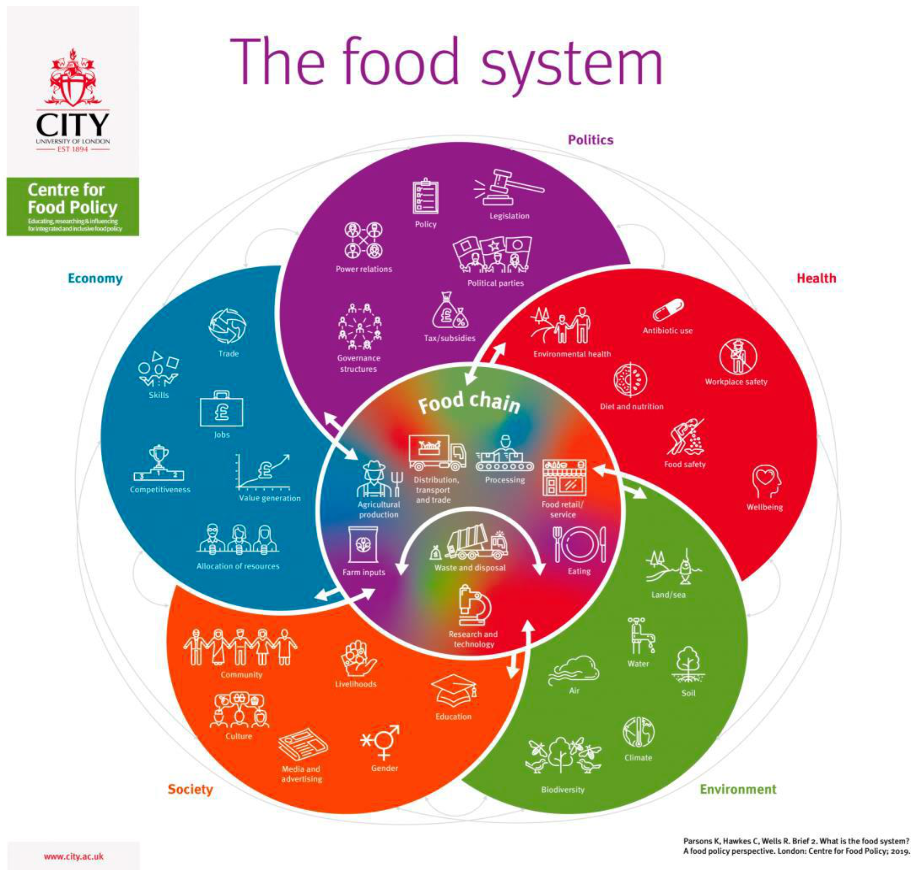
Appendix C
| Food Literacy Framework | |||
|---|---|---|---|
| Country: England | |||
| Food Literacy Competencies | Curriculum Subject | ||
| RSE&HE | D&T | Science | |
| Confidence & Empowerment with Food | |||
| Have a basic nutrition knowledge: | |||
| Understanding food groups and portion sizes. | 0 | 0 | 1 |
| Understanding the link between dietary choices and health. | 3 | 3 | 1 |
| Understanding the role of nutrients in the body. | 2 | 0 | 3 |
| Understanding the nutrition composition of different foods. | 0 | 0 | 2 |
| Understanding energy balance. | 1 | 0 | 0 |
| Understanding different eating “lifestyles” (e.g., vegetarianism) and life stages (e.g., the changing food needs of babies, children and elderly). | 0 | 0 | 0 |
| Understanding nutrition claims about food. | 0 | 0 | 0 |
| Understanding healthy eating and current guidelines. | 3 | 3 | 3 |
| Being able to use technology to find credible nutrition information. | 0 | 0 | 0 |
| Total score for Nutrition knowledge | 9 | 6 | 10 |
| Have food safety & hygiene knowledge: | |||
| Understanding food safety risks associated with food storage and preparation. | 0 | 0 | 0 |
| Understanding hygienic food handling practices. | 1 | 0 | 1 |
| Total score for Hygiene | 1 | 0 | 1 |
| Have knowledge of where food comes from: | |||
| Understanding food origins. | 0 | 3 | 3 |
| Understanding seasonality of food. | 0 | 3 | 3 |
| Understanding where to access food. | 0 | 0 | 0 |
| Understanding the impact of food systems on the environment and local economy. | 0 | 0 | 0 |
| Understanding how to grow food. | 0 | 0 | 2 |
| Total score for Where food comes from | 0 | 6 | 8 |
| Be able to successfully navigate the grocery store to make healthy and economical food choices: | |||
| Being able to compare food costs to make economical food choices. | 0 | 1 | 0 |
| Being able to compare foods to make healthy food choices (by interpreting labels and packaging). | 1 | 0 | 0 |
| Being able to stock a pantry with staple ingredients. | 0 | 0 | 0 |
| Total score for make healthy, economical food choices | 1 | 1 | 0 |
| Have food preparation skills: | |||
| Being able to prepare meals with basic ingredients. | 1 | 1 | 0 |
| Being able to use basic kitchen equipment and tools. | 1 | 1 | 0 |
| Being able to read/follow a recipe. | 1 | 1 | 0 |
| Being able to plan for food/meals ahead of time. | 0 | 0 | 0 |
| Being able to cook with and for others. | 0 | 1 | 0 |
| Being able to use technology to find appropriate recipes. | 0 | 0 | 0 |
| Total score for Food preparation skills | 3 | 4 | 0 |
| Have food budgeting skills: | |||
| Being able to develop a food budget. | 0 | 0 | 0 |
| Being able to select healthy foods within a budget. | 0 | 2 | 0 |
| Total score for Budgeting skills | 0 | 2 | 0 |
| Have a healthy food relationship: | |||
| Having positive attitudes around food and eating. | 1 | 0 | 0 |
| Understanding the relationship between body weight and health (e.g., body weight does not equal health). | 1 | 0 | 0 |
| Having healthy body image and self-esteem. | 0 | 0 | 0 |
| Understanding that all foods can have a positive role in our diets. | 0 | 0 | 0 |
| Understanding the role of the senses in eating. | 0 | 0 | 2 |
| Total score for Healthy food relationship | 2 | 0 | 2 |
| Be able to think critically about and act on food and nutrition issues: | |||
| Being able to advocate for the availability of healthy foods in the community. | 0 | 0 | 0 |
| Understanding food and weight loss/supplement industry interests and marketing strategies. | 0 | 0 | 0 |
| Understanding media reports on food and nutrition. | 0 | 0 | 0 |
| Total score for Critical thinking on food issues | 0 | 0 | 0 |
| Joy & Meaning through Food | |||
| Have a positive relationship with food: | |||
| Enjoying food and eating. | 0 | 1 | 0 |
| Making food choices that promote well-being. | 0 | 0 | 0 |
| Engaging in mindful eating practices. | 0 | 0 | 0 |
| Preparing food in a fun and enjoyable way. | 0 | 0 | 0 |
| Enjoying preparing new and diverse foods. | 0 | 0 | 0 |
| Total score for Positive food relationship | 0 | 1 | 0 |
| Enjoy cultural foods: | |||
| Passing on family food traditions through celebrations, cultural foods, and family recipes. | 0 | 0 | 0 |
| Appreciating foods from different cultures. | 0 | 0 | 0 |
| Being able to access foods particular to one’s culture. | 0 | 0 | 0 |
| Total score for Enjoying cultural foods | 0 | 0 | 0 |
| Have experienced new and varied foods: | |||
| Being open to eating new and diverse foods. | 0 | 0 | 1 |
| Enjoying cooking new and diverse foods. | 0 | 0 | 1 |
| Total score for Open to varied food | 0 | 0 | 2 |
| Value local food systems: | |||
| Appreciating the role of local foods for community well-being. | 0 | 0 | 0 |
| Total score for Valuing local FS | 0 | 0 | 0 |
| Recognise the importance of preparing and eating food with/for others: | |||
| Valuing sharing food with others. | 0 | 0 | 0 |
| Valuing everyday family meals. | 0 | 0 | 0 |
| Valuing preparing food together. | 0 | 0 | 0 |
| Valuing preparing food for others. | 0 | 1 | 0 |
| Total score for Valuing eating together | 0 | 1 | 0 |
| Equity & Sustainability for Food Systems | |||
| Understanding the food system: | |||
| Understanding the role of politics and economics in the food system. | 0 | 0 | 0 |
| Total score for Understanding the FS | 0 | 0 | 0 |
| Understand social justice issues in the food system: | |||
| Understanding food security issues at individual, community and global levels. | 0 | 0 | 0 |
| Understanding ethical issues in food production. | 0 | 0 | 0 |
| Recognising farming as a career option. | 0 | 0 | 0 |
| Understanding social justice implications of food choices. | 0 | 0 | 0 |
| Total score for Understanding FS social justice | 0 | 0 | 0 |
| Understanding the influence of food corporations and lobbying interests: | |||
| Being able to think critically about the influence of food corporations, lobby groups and media on food choices. | 0 | 0 | 0 |
| Total score for Lobby and media influence | 0 | 0 | 0 |
| Understand aspects of environmentally sustainable food systems: | |||
| Being able to think critically about the link between food origins and sustainability. | 0 | 0 | 0 |
| Understanding how food systems can be more sustainable and equitable. | 0 | 0 | 0 |
| Understanding the impact of food production on the environment. | 0 | 0 | 0 |
| Understanding the impact of food waste. | 0 | 0 | 0 |
| Choosing and preparing foods to support sustainable eating. | 0 | 0 | 0 |
| Understanding food production and distribution systems (farming, harvesting, shipping, processing, marketing and distribution). | 0 | 0 | 0 |
| Total score for Sustainable FS | 0 | 0 | 0 |
Appendix D. List of Curriculums That Met the Inclusion Criteria Analysed against the FL Framework. Source: Authors
- Czech Republic—Three curriculums met the inclusion criteria and include Humans and their work, Humans and their world and Cross Curriculum [102].
- Iceland—Three curriculums met the selection criteria and included HE, Natural Sciences, and Social science [104].
- Sweden—Three curriculums met the inclusion criteria, namely Home and Consumer Studies (HCS), Science and Geography [93].
References
- GLOPAN. Future Food Systems: For People, Our Planet, and Prosperity; The Global Panel on Agriculture and Food Systems for Nutrition: London, UK, 2020; Available online: https://www.glopan.org/wp-content/uploads/2020/11/Foresight-2_WEB_2Nov.pdf (accessed on 17 November 2020).
- FOLU. Growing Better Report Ten Critical Transitions to Transform Food and Land Use. 2019. Available online: https://www.foodandlandusecoalition.org/wp-content/uploads/2019/09/FOLU-GrowingBetter-GlobalReport.pdf (accessed on 17 November 2020).
- Willett, W.; Rockström, J.; Loken, B.; Springmann, M.; Lang, T.; Vermeulen, S.; Garnett, T.; Tilman, D.; DeClerck, F.; Wood, A.; et al. Food in the Anthropocene: The EAT—Lancet commission on healthy diets from sustainable food systems. Lancet 2019, 393, 447–492. [Google Scholar] [CrossRef]
- Hawkes, C.; Parsons, K.; Wells, R. Brief 2: Understanding the food system: Why it matters for food policy. In Rethinking Food Policy: A Fresh Approach to Policy and Practice; Centre for Food Policy: London, UK, 2019. [Google Scholar]
- UN. Action Track Discussion Starter. Action Track 2—Shift to Healthy and Sustainable Consumption Patterns. 2020. Available online: https://www.un.org/sites/un2.un.org/files/at_2_discussion_starter.pdf (accessed on 17 November 2020).
- WHO. Global Strategy on Diet, Physical Activity and Health. 2018. Available online: https://www.who.int/dietphysicalactivity/childhood_schools/en/ (accessed on 27 October 2019).
- FAO. FAO School Food and Nutrition Framework. 2019. Available online: http://www.fao.org/3/ca4091en/CA4091EN.pdf (accessed on 17 November 2020).
- WHO. Food and Nutrition Policy for Schools. 2006. Available online: https://apps.who.int/iris/bitstream/handle/10665/107797/E89501.pdf?sequence=1&isAllowed=y (accessed on 17 November 2020).
- Otto, S.; Evans, G.W.; Moon, M.J.; Kaiser, F.G. The development of children’s environmental attitude and behavior. Glob. Environ. Chang. 2019, 58, 101947. [Google Scholar] [CrossRef]
- Lavelle, F.; Spence, M.; Hollywood, L.; McGowan, L.; Surgenor, D.; McCloat, A.; Mooney, E.; Caraher, M.; Raats, M.; Dean, M. Learning cooking skills at different ages: A cross-sectional study. Int. J. Behav. Nutr. Phys. Act. 2016, 13, 119. [Google Scholar] [CrossRef] [PubMed]
- Worsley, A. Does school health and home economics education influence adults’ food knowledge? Health Promot. Int. 2015, 31, 925. [Google Scholar] [CrossRef]
- Laska, M.N.; Larson, N.I.; Neumark-Sztainer, D.; Story, M. Does involvement in food preparation track from adolescence to young adulthood and is it associated with better dietary quality? Findings from a 10-year longitudinal study. Public Health Nutr. 2012, 15, 1150–1158. [Google Scholar] [CrossRef]
- Storcksdieck genannt Bonsmann, S. Comprehensive mapping of national school food policies across the European Union plus Norway and Switzerland. Nutr. Bull. 2014, 39, 369–373. [Google Scholar] [CrossRef]
- Osowski, C.P.; Göranzon, H.; Fjellström, C. Teachers’ interaction with children in the school meal situation: The example of pedagogic meals in Sweden. J. Nutr. Educ. Behav. 2013, 45, 420–427. [Google Scholar] [CrossRef]
- WHO. Commission on Ending Childhood Obesity. 2016. Available online: https://www.who.int/end-childhood-obesity/final-report/en/ (accessed on 17 November 2020).
- JOFF—Jamie Oliver Food Foundation. A Report on the Food Education Learning Landscape. 2017. Available online: https://www.akofoundation.org/wp-content/uploads/2017/11/2_0_fell-report-final.pdf (accessed on 1 July 2020).
- Ofsted. Obesity, Healthy Eating and Physical Activity in Primary Schools. A Thematic Review into What Actions Schools are Taking to Reduce Childhood Obesity. 2018. Available online: https://assets.publishing.service.gov.uk/government/uploads/system/uploads/attachment_data/file/726114/Obesity__healthy_eating_and_physical_activity_in_primary_schools_170718.pdf (accessed on 7 October 2020).
- Cambridge Dictionary. Meaning of Home Economics in English. 2020. Available online: https://dictionary.cambridge.org/dictionary/english/home-economics?q=HOME+ECONOMICS (accessed on 6 October 2020).
- International Federation of Home Economics. What Is Home Economics? 2020. Available online: http://www.ifhe.org.uk/home-economics (accessed on 6 October 2020).
- Fine, G. Is there a future for food education in schools? Des. Technol. Teach. 1994, 26, 39–44. [Google Scholar]
- Contento, I.R. What’s in a Name? [PowerPoint Presentation]. SNEB Webinar. 2016. Available online: https://www.sneb.org/clientuploads/directory/Recorded_Webinars/Webinar_Handouts/Contento-notes.pdf (accessed on 6 October 2020).
- McGowan, L.; Caraher, M.; Raats, M.; Lavelle, F.; Hollywood, L.; McDowell, D.; Spence, M.; McCloat, A.; Mooney, E.; Dean, M. Domestic cooking and food skills: A review. Crit. Rev. Food Sci. Nutr. 2015, 57, 2412–2431. [Google Scholar] [CrossRef]
- Sutter, C. Defining food education standards through consensus: The pilot light food education summit. J. Sch. Health 2019, 89, 994. [Google Scholar] [CrossRef]
- Cullen, T.; Hatch, J.; Martin, W.; Higgins, J.W.; Sheppard, R. Food literacy: Definition and framework for action. Can. J. Diet. Pract. Res. 2015, 76, 140–145. [Google Scholar] [CrossRef]
- Mustonen, S.; Rantanen, R.; Tuorila, H. Effect of sensory education on school children’s food perception: A 2-year follow-up study. Food Qual. Prefer. 2009, 20, 230–240. [Google Scholar] [CrossRef]
- McCloat, A.; Caraher, M. The evolution of Home Economics as a subject in Irish primary and post-primary education from the 1800s to the twenty-first century. Ir. Educ. Stud. 2019, 38, 377–399. [Google Scholar] [CrossRef]
- Ioannou, S.; Kouta, C.; Andreou, A. Cyprus health education curriculum from ‘victim blaming to empowerment’. Health Educ. 2015, 115, 392–404. [Google Scholar] [CrossRef]
- Nguyen, K.A.; De Villiers, A.; Fourie, J.M.; Hendricks, M. Challenges to implementing the food-based dietary guidelines in the South African primary school curriculum: A qualitative study exploring the perceptions of principals and curriculum advisors. S. Afr. J. Clin. Nutr. 2017, 30, 15–20. [Google Scholar] [CrossRef][Green Version]
- Morrison, M. A curriculum for food: Places left at the school table? Curric. J. 1996, 7, 51–73. [Google Scholar] [CrossRef]
- Robertson, L.; Scheidler-Benns, J. Using a wider lens to shift the discourse on food in Canadian curriculum policies. Camb. J. Educ. Food Youth Educ. 2016, 46, 157–175. [Google Scholar] [CrossRef]
- Nutrition Connections. Policies That Influence Food Literacy among Children and Youth in Ontario. 2019. Available online: https://nutritionconnections.ca/resources/policies-that-influence-food-literacy-among-children-and-youth-in-ontario/ (accessed on 1 July 2020).
- Tull, A. Food and Cooking Skills Education: Why Teach People How to Cook? Routledge, Taylor & Francis Group: London, UK, 2018. [Google Scholar]
- McCloat, A.; Caraher, M. An international review of second-level food education curriculum policy. Camb. J. Educ. 2020, 50, 303–324. [Google Scholar] [CrossRef]
- Vardanjani, A.; Reisi, M.; Javadzade, H.; Pour, Z.; Tavassoli, E. The effect of nutrition education on knowledge, attitude, and performance about junk food consumption among students of female primary schools. J. Educ. Health Promot. 2015, 4, 53. [Google Scholar]
- Segrott, J.; Holliday, J.; Murphy, S.; Macdonald, S.; Roberts, J.; Moore, L.; Phillips, C. Implementation of a Cooking Bus intervention to support cooking in schools in Wales, UK. Health Educ. 2017, 117, 234–251. [Google Scholar] [CrossRef]
- Adab, P.; Barrett, T.; Bhopal, R.; Cade, J.E.; Canaway, A.; Cheng, K.K.; Clarke, J.; Daley, A.; Deeks, J.; Duda, J.; et al. The West Midlands ActiVe lifestyle and healthy Eating in School children (WAVES) study: A cluster randomised controlled trial testing the clinical effectiveness and cost-effectiveness of a multifaceted obesity prevention intervention programme targeted at children aged 6–7 years. Health Technol. Assess. 2018, 22, 1–608. [Google Scholar]
- Ohly, H.; Gentry, S.; Wigglesworth, R.; Bethel, A.; Lovell, R.; Garside, R. A systematic review of the health and well-being impacts of school gardening: Synthesis of quantitative and qualitative evidence. BMC Public Health 2016, 16, 286. [Google Scholar] [CrossRef]
- Al Ali, N.; Arriaga, A.; Rubio, M. The cognitive and behavioral impact of a culinary education program on schoolchildren. Nutr. Food Sci. 2020, 51, 10–29. [Google Scholar] [CrossRef]
- Block, K.; Gibbs, L.; Staiger, P.K.; Gold, L.; Johnson, B.; Macfarlane, S.; Long, C.; Townsend, M. Growing community: The impact of the Stephanie Alexander Kitchen Garden Program on the social and learning environment in primary schools. Health Educ. Behav. 2012, 39, 419–432. [Google Scholar] [CrossRef]
- Robinson-O’Brien, R.; Story, M.; Heim, S. Impact of garden-based youth nutrition intervention programs: A review. J. Am. Diet. Assoc. 2009, 109, 273–280. [Google Scholar] [CrossRef]
- Jarpe-Ratner, E.; Folkens, S.; Sharma, S.; Daro, D.; Edens, N.K. An experiential cooking and nutrition education program increases cooking self-efficacy and vegetable consumption in children in grades 3–8. J. Nutr. Educ. Behav. 2016, 48, 697–705.e1. [Google Scholar] [CrossRef]
- Landry, M.; Asigbee, F.; Vandyousefi, S.; Jeans, M.; Ghaddar, R.; Hoelscher, D.; Van Den Berg, A.; Davis, J. Effects of TX sprouts, a school-based cluster randomized gardening, nutrition, and cooking intervention, on dietary quality. Curr. Dev. Nutr. 2020, 4 (Suppl. S2), 1321. [Google Scholar] [CrossRef]
- Cunningham-Sabo, L.; Lohse, B. Impact of a school-based cooking curriculum for fourth-grade students on attitudes and behaviors is influenced by gender and prior cooking experience. J. Nutr. Educ. Behav. 2014, 46, 110–120. [Google Scholar] [CrossRef]
- Jones, M.; Dailami, N.; Weitkamp, E.; Salmon, D.; Kimberlee, R.; Morley, A.; Orme, J. Food sustainability education as a route to healthier eating: Evaluation of a multi-component school programme in English primary schools. Health Educ. Res. 2012, 27, 448–458. [Google Scholar] [CrossRef]
- Roseno, A.T.; Carraway-Stage, V.G.; Hoerdeman, C.; Díaz, S.R.; Geist, E.; Duffrin, M.W. Applying mathematical concepts with hands-on, food-based science curriculum: Applying mathematical concepts. Sch. Sci. Math. 2015, 115, 14–21. [Google Scholar] [CrossRef]
- Follong, B.; Prieto-Rodriguez, E.; Miller, A.; Collins, C.; Bucher, T. P76 CUPS: A teaching unit integrating nutrition and mathematics to improve primary school children’s portion size estimation. J. Nutr. Educ. Behav. 2020, 52, S52. [Google Scholar] [CrossRef]
- Luna, M.J.; Rye, J.A.; Forinash, M.; Minor, A. Gardening for homonyms: Integrating science and language arts to support children’s creative use of multiple meaning words. Sci. Act. 2015, 52, 92–105. [Google Scholar] [CrossRef]
- Hovland, J.A.; Carraway-Stage, V.G.; Cela, A.; Collins, C.; Díaz, S.R.; Collins, A.; Duffrin, M.W. Food-based science curriculum increases 4th graders multidisciplinary science knowledge. J. Food Sci. Educ. 2013, 12, 81–86. [Google Scholar] [CrossRef] [PubMed][Green Version]
- Truman, E. Defining food literacy: A scoping review. Appetite 2017, 116, 365. [Google Scholar] [CrossRef]
- Benn, J. Food, nutrition or cooking literacy—A review of concepts and competencies regarding food education. Int. J. Home Econ. 2014, 7, 13. [Google Scholar]
- Azevedo Perry, E.; Thomas, H.; Samra, H.R.; Edmonstone, S.; Davidson, L.; Faulkner, A.; Petermann, L.; Manafò, E.; Kirkpatrick, S.I. Identifying attributes of food literacy: A scoping review. Public Health Nutr. 2017, 20, 2406–2415. [Google Scholar] [CrossRef]
- Fingland, D.; Thompson, C.; Vidgen, H.A. Measuring food literacy: Progressing the development of an international food literacy survey using a content validity study. Int. J. Environ. Res. Public Health 2021, 18, 1141. [Google Scholar] [CrossRef]
- Bailey, C.J.; Drummond, M.J.; Ward, P.R. Food literacy programmes in secondary schools: A systematic literature review and narrative synthesis of quantitative and qualitative evidence. Public Health Nutr. 2019, 22, 2891–2913. [Google Scholar] [CrossRef]
- Forray, A.I.; Gologan, A.G.; Coman, M.; Cherecheş, R.M.; Petraeus, D.; Vizitiu, S.; Borzan, C.M. A pilot study to examine the effects of a school-based intervention for promoting food and nutrition literacy (FNLIT) in Romanian school children. Public Health Manag. 2021, 26, 12–17. [Google Scholar] [CrossRef]
- Kelly, R.K.; Nash, R. Food literacy interventions in elementary schools: A systematic scoping review. J. Sch. Health 2021, 91, 660–669. [Google Scholar] [CrossRef]
- Vaitkeviciute, R. The relationship between food literacy and dietary intake in adolescents: A systematic review. Public Health Nutr. 2015, 18, 649. [Google Scholar] [CrossRef]
- Park, D.; Choi, M.K.; Park, Y.K.; Park, C.Y.; Shin, M.J. Higher food literacy scores are associated with healthier diet quality in children and adolescents: The development and validation of a two-dimensional food literacy measurement tool for children and adolescents. Nutr. Res. Pract. 2021, 16, e1. [Google Scholar]
- Park, D.; Park, Y.K.; Park, C.Y.; Choi, M.K.; Shin, M.J. Development of a comprehensive food literacy measurement tool integrating the food system and sustainability. Nutrients 2020, 12, 3300. [Google Scholar] [CrossRef]
- Smith, M.G. Food or nutrition literacy? What concept should guide home economics education. Int. J. Home Econ. 2009, 2, 48. [Google Scholar]
- Pendergast, D.; Dewhurst, Y. Home economics and food literacy: An international investigation. Int. J. Home Econ. 2012, 5, 245. [Google Scholar]
- Ronto, R.; Ball, L.; Pendergast, D.; Harris, N.D. Food literacy at secondary schools in Australia. J. Sch. Health 2016, 86, 823–831. [Google Scholar] [CrossRef]
- Nanayakkara, J.; Margerison, C.; Worsley, A. Senior secondary school food literacy education: Importance, challenges, and ways of improving. Nutrients 2018, 10, 1316. [Google Scholar] [CrossRef]
- Hemmer, A.; Fightmaster, C.; Lim, Y.S.; Kovacic, M.B.; Lee, S.Y. Reliability of the Food Literacy Assessment Tool (FLAT) in low-income adults. J. Nutr. Educ. Behav. 2020, 52, S61. [Google Scholar] [CrossRef]
- Sumner, J. Reading the world: Food literacy and the potential for food system transformation. Stud. Educ. Adults 2015, 47, 128–141. [Google Scholar] [CrossRef]
- Wijayaratne, S.P.; Reid, M.; Westberg, K.; Worsley, A.; Mavondo, F. Food literacy, healthy eating barriers and household diet. Eur. J. Mark. 2018, 52, 2449–2477. [Google Scholar] [CrossRef]
- Fernandez, M.A.; Desroches, S.; Marquis, M.; Lebel, A.; Turcotte, M.; Provencher, V. Which food literacy dimensions are associated with diet quality among Canadian parents? Br. Food J. 2019, 121, 1670–1685. [Google Scholar] [CrossRef]
- Wickham, C.A.; Carbone, E.T. What’s technology cooking up? A systematic review of the use of technology in adolescent food literacy programs. Appetite 2018, 125, 333–344. [Google Scholar] [CrossRef]
- Brooks, N.; Begley, A. Adolescent food literacy programmes: A review of the literature. Nutr. Diet. 2014, 71, 158–171. [Google Scholar] [CrossRef]
- Stjernqvist, N.W.; Elsborg, P.; Ljungmann, C.K.; Benn, J.; Bonde, A.H. Development and validation of a food literacy instrument for school children in a Danish context. Appetite 2020, 156, 104848. [Google Scholar] [CrossRef]
- Carroll, N.; Perreault, M.; Ma, D.W.; Haines, J. Assessing food and nutrition literacy in children and adolescents: A systematic review of existing tools. Public Health Nutr. 2021, 1–16. [Google Scholar] [CrossRef]
- Amin, S.A.; Panzarella, C.; Lehnerd, M.; Cash, S.B.; Economos, C.D.; Sacheck, J.M. Identifying food literacy educational opportunities for youth. Health Educ. Behav. 2018, 45, 918–925. [Google Scholar] [CrossRef]
- Doustmohammadian, A.; Omidvar, N.; Keshavarz-Mohammadi, N.; Eini-Zinab, H.; Amini, M.; Abdollahi, M.; Amirhamidi, Z.; Haidari, H. Low food and nutrition literacy (FNLIT): A barrier to dietary diversity and nutrient adequacy in school age children. BMC Res. Notes 2020, 13, 286. [Google Scholar] [CrossRef]
- Ware, L.M.; Cameron, C.M.; Davis, N.J.; Power, D.J.; Russell, K.L.; Skeaff, C.M.; Skeaff, S.A. Food literacy of New Zealand schoolchildren. J. Nutr. Intermed. Metab. 2017, 8, 76. [Google Scholar] [CrossRef]
- Skeaff, S.; Govan, A.; Skeaff, M. A practical kitchen-based validation of the food skills section of a food literacy questionnaire for 9–10 year old children. Curr. Dev. Nutr. 2020, 4 (Suppl. S2), 1349. [Google Scholar] [CrossRef]
- Fordyce-Voorham, S.; Lai-Yeung, T.W. Developing food literacy through the education sector: A focus on home economics. In Food Literacy; Vidgen, H., Ed.; Routledge: London, UK, 2016; pp. 165–185. [Google Scholar]
- Slater, J.; Falkenberg, T.; Rutherford, J.; Colatruglio, S. Food literacy competencies: A conceptual framework for youth transitioning to adulthood. Int. J. Consum. Stud. 2018, 42, 547–556. [Google Scholar] [CrossRef]
- Kridel, C.A. Encyclopedia of Curriculum Studies; SAGE: London, UK; Los Angeles, CA, USA, 2010. [Google Scholar]
- Yin, R.K. Case Study Research: Design and Methods, 4th ed.; Sage: London, UK; Los Angeles, CA, USA, 2009. [Google Scholar]
- Utdanningsdirektoratet. Læreplan i Mat og Helse (Curriculum in Food and Health). 2020. Available online: https://www.udir.no/lk20/mhe01-02?lang=nno (accessed on 21 October 2020).
- Education Scotland. Curriculum for Excellence: Health and Wellbeing, Experience and Outcomes. 2016. Available online: https://education.gov.scot/Documents/health-and-wellbeing-eo.pdf (accessed on 21 October 2020).
- EMU. Nature/Technology. 2020. Available online: https://emu.dk/grundskole/naturteknologi/faghaefte-faelles-mal-laeseplan-og-vejledning (accessed on 20 October 2020).
- Education Scotland. Benchmarks. Social Studies. 2017. Available online: https://education.gov.scot/nih/Documents/Social%20StudiesBenchmarksPDF.pdf (accessed on 21 October 2020).
- Australian Curriculum. Intercultural Understanding. 2020. Available online: https://www.australiancurriculum.edu.au/f-10-curriculum/general-capabilities/intercultural-understanding/ (accessed on 20 October 2020).
- Education Scotland. Benchmarks. Technologies. 2017. Available online: https://education.gov.scot/nih/Documents/TechnologiesBenchmarksPDF.pdf (accessed on 21 October 2020).
- DFE. Design and Technology Programmes of Study: Key Stages 1 and 2 National Curriculum in England. 2013. Available online: https://assets.publishing.service.gov.uk/government/uploads/system/uploads/attachment_data/file/239041/PRIMARY_national_curriculum_-_Design_and_technology.pdf (accessed on 12 October 2020).
- Burns, J. ‘Cheese is from plants’—Study Reveals Child Confusion. BBC News. 3 June 2013. Available online: https://www.bbc.co.uk/news/education-22730613 (accessed on 10 November 2020).
- Vidgen, H. Food Literacy; Routledge: London, UK, 2016. [Google Scholar]
- Dudley, D.A.; Cotton, W.G.; Peralta, L.R. Teaching approaches and strategies that promote healthy eating in primary school children: A systematic review and meta-analysis. Int. J. Behav. Nutr. Phys. Act. 2015, 12, 28. [Google Scholar] [CrossRef] [PubMed]
- Uzşen, H.; Başbakkal, Z.D. A game-based nutrition education: Teaching healthy eating to primary school students. J. Pediatr. Res. 2019, 6, 18–23. [Google Scholar] [CrossRef]
- Cotton, W.; Dudley, D.; Peralta, L.; Werkhoven, T. The effect of teacher-delivered nutrition education programs on elementary-aged students: An updated systematic review and meta-analysis. Prev. Med. Rep. 2020, 20, 101178. [Google Scholar] [CrossRef] [PubMed]
- Yip, C.; Gates, M.; Gates, A.; Hanning, R.M. Peer-led nutrition education programs for school-aged youth: A systematic review of the literature. Health Educ. Res. 2016, 31, 82–97. [Google Scholar] [CrossRef]
- Victor, A. Three-Quarters of British Children Don’t Know How to Boil an Egg and 30% Have Never Chopped Vegetables, Survey Reveals. Mail Online. 5 October 2015. Available online: https://www.dailymail.co.uk/femail/food/article-3260435/British-children-say-love-cooking-unable-chop-vegetables-make-salad-boil-egg.html (accessed on 18 November 2020).
- Skolverket. Curriculum for the Compulsory School, Preschool Class and School-Age Educare. 2018. Available online: https://www.skolverket.se/download/18.31c292d516e7445866a218f/1576654682907/pdf3984.pdf (accessed on 29 October 2020).
- Duncombe, R.; Cale, L.; Harris, J. Strengthening ‘the foundations’ of the primary school curriculum. Education 2018, 46, 76–88. [Google Scholar] [CrossRef]
- Lang, T.; Barling, D.; Caraher, M. Food Policy: Integrating Health, Environment and Society; Oxford University Press: New York, NY, USA; Oxford, UK, 2009. [Google Scholar]
- Ritchie, J. Food reciprocity and sustainability in early childhood care and education in Aotearoa New Zealand. Aust. J. Environ. Educ. 2015, 31, 74–85. [Google Scholar] [CrossRef]
- Caraher, M.; Seeley, A.; Wu, M.; Lloyd, S. When chefs adopt a school? An evaluation of a cooking intervention in English primary schools. Appetite 2013, 62, 50–59. [Google Scholar] [CrossRef]
- DFE. Relationships and Sex Education (RSE) and Health Education. 2020. Available online: https://www.gov.uk/government/publications/relationships-education-relationships-and-sex-education-rse-and-health-education (accessed on 12 October 2020).
- Australian Curriculum. Design and Technologies. 2020. Available online: https://www.australiancurriculum.edu.au/f-10-curriculum/technologies/design-and-technologies/ (accessed on 20 October 2020).
- Australian Curriculum. Health and Physical Education. 2020. Available online: https://www.australiancurriculum.edu.au/f-10-curriculum/health-and-physical-education/ (accessed on 20 October 2020).
- Australian Curriculum. Science. 2020. Available online: https://www.australiancurriculum.edu.au/f-10-curriculum/science/ (accessed on 20 October 2020).
- MSMT. The Framework Educational Programme for Basic Education. 2007. Available online: https://www.msmt.cz/areas-of-work/basic-education-1?lang=2 (accessed on 30 October 2020).
- EMU. Health and Sex Education and Family Knowledge. 2020. Available online: https://emu.dk/grundskole/sundheds-og-seksualundervisning-og-familiekundskab (accessed on 20 October 2020).
- Ministry of Education, Science and Culture. The Icelandic National Curriculum Guide for Compulsory Schools—With Subjects Areas. 2014. Available online: https://www.government.is/lisalib/getfile.aspx?itemid=3e4939f1-cb84-11e7-9421-005056bc530c (accessed on 21 October 2020).
- Government of Ireland. Social, Personal and Health Education Curriculum. 1999. Available online: https://www.curriculumonline.ie/getmedia/462570f8-27cc-4f5b-a13e-d1e2de8c18d2/PSEC06_SPHE_curriculum.pdf (accessed on 29 October 2020).
- Government of Ireland. Science Curriculum. 1999. Available online: https://www.curriculumonline.ie/getmedia/346522bd-f9f6-49ce-9676-49b59fdb5505/PSEC03c_Science_Curriculum.pdf (accessed on 29 October 2020).
- Government of Ireland. Geography Curriculum. 1999. Available online: https://www.curriculumonline.ie/Primary/Curriculum-Areas/Social-Environmental-and-Scientific-Education/Geography/ (accessed on 29 October 2020).
- MEXT. Section 8 Home Economics. 2009. Available online: https://www.mext.go.jp/component/english/__icsFiles/afieldfile/2011/03/17/1303755_009.pdF (accessed on 29 October 2020).
- MEXT. Section 4 Science. 2009. Available online: https://www.mext.go.jp/component/english/__icsFiles/afieldfile/2011/03/17/1303755_005.pdf (accessed on 29 October 2020).
- MEXT. Section 5 Living Environment Studies. 2009. Available online: https://www.mext.go.jp/component/english/__icsFiles/afieldfile/2011/03/17/1303755_006.pdf (accessed on 29 October 2020).
- MEXT. Section 9 Physical Education. 2009. Available online: https://www.mext.go.jp/component/english/__icsFiles/afieldfile/2011/03/17/1303755_010.pdf (accessed on 29 October 2020).
- Utdanningsdirektoratet. Læreplan i Naturfag (Curriculum in Science). 2020. Available online: https://www.udir.no/lk20/nat01-04 (accessed on 20 October 2020).
- Education Scotland. Curriculum for Excellence: Technologies, Experience and Outcomes. 2016. Available online: https://education.gov.scot/Documents/Technologies-es-os.pdf (accessed on 21 October 2020).
- Education Scotland. Curriculum for Excellence: Science, Experience and Outcomes. 2016. Available online: https://education.gov.scot/media/jcxpmwd5/sciences-eo.pdf (accessed on 21 October 2020).
- Republika Slovenija. Program Osnovna Šola GOSPODINJSTVO Učni Načrt (Elementary School Programme. Household Curriculum). 2011. Available online: https://www.gov.si/assets/ministrstva/MIZS/Dokumenti/Osnovna-sola/Ucni-nacrti/obvezni/UN_spoznavanje_okolja_pop.pdf (accessed on 29 October 2020).
- Republika Slovenija. Program Osnovna Šola SPOZNAVANJE OKOLJA Učni Načrt (Elementary School Programme. Knowledge of the Environment Curriculum). 2011. Available online: https://www.gov.si/assets/ministrstva/MIZS/Dokumenti/Osnovna-sola/Ucni-nacrti/obvezni/UN_spoznavanje_okolja_pop.pdf (accessed on 29 October 2020).
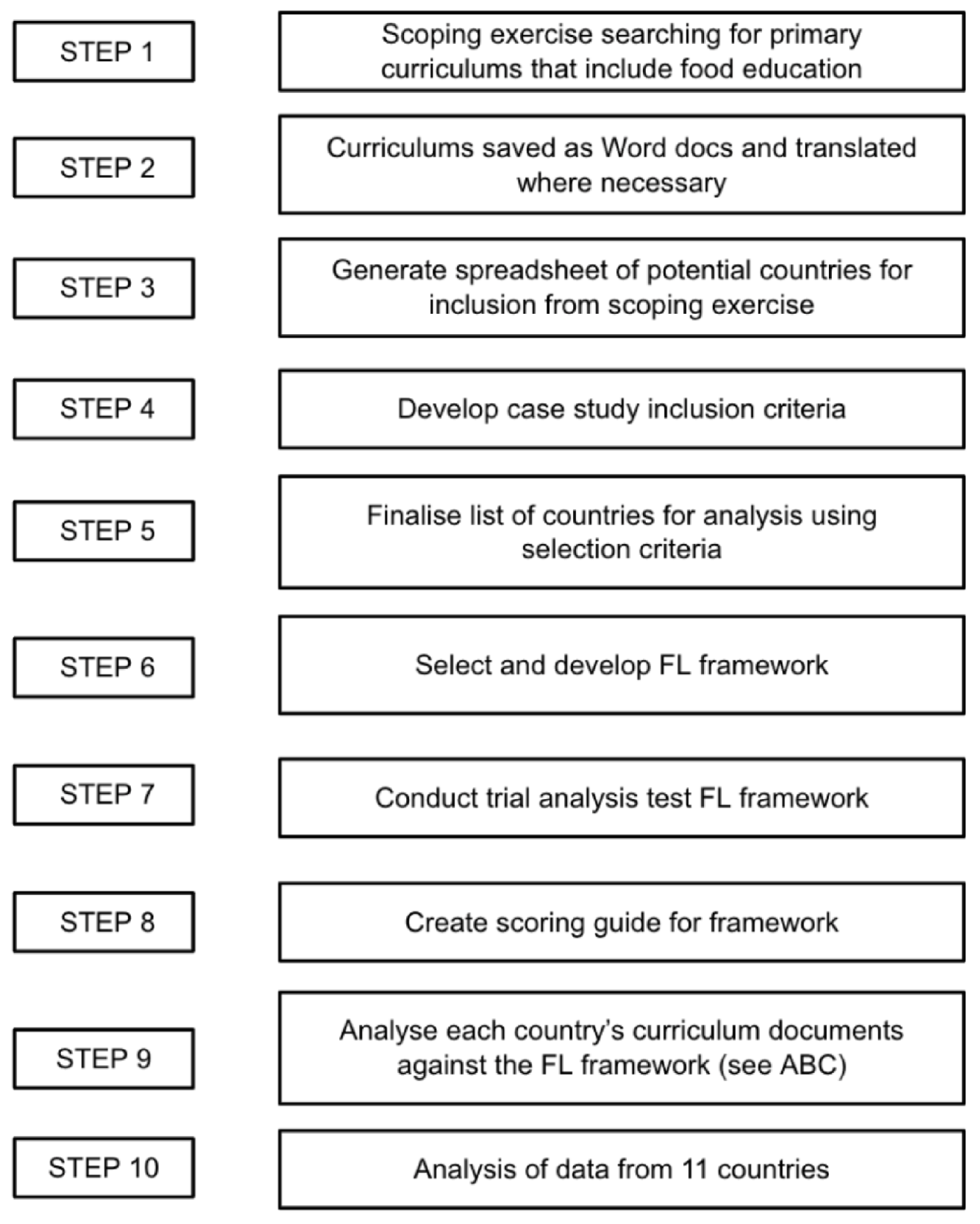
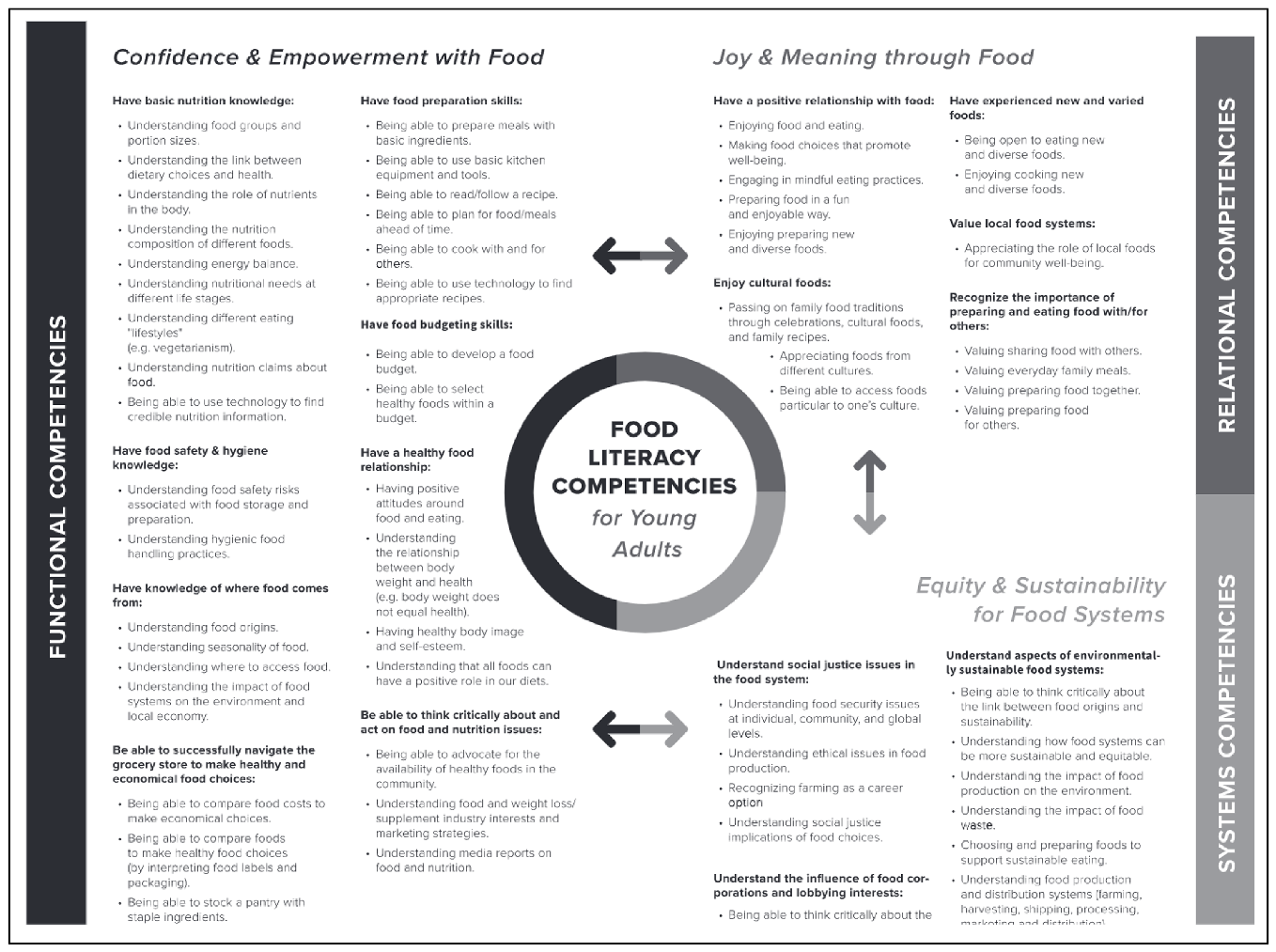
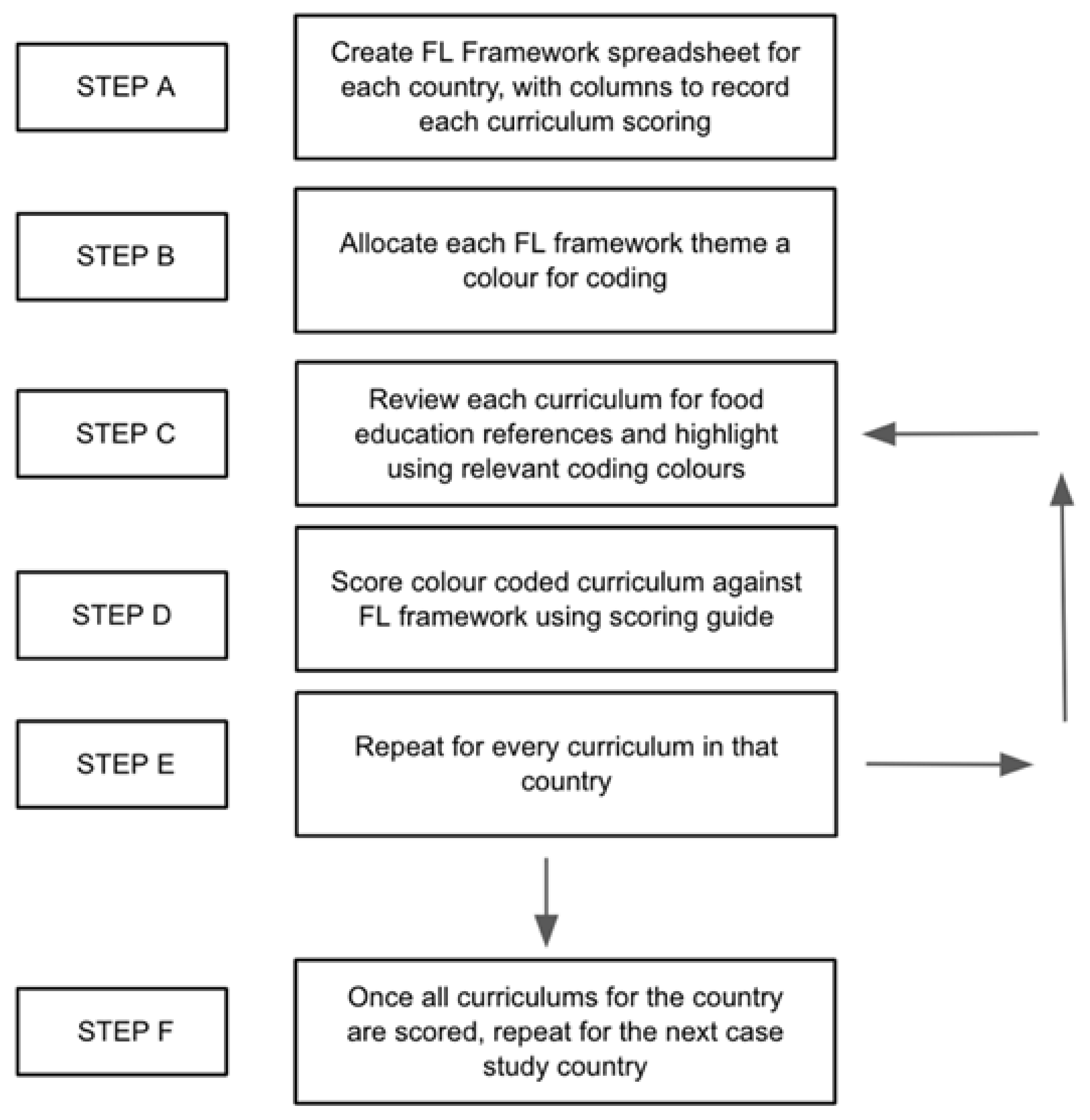
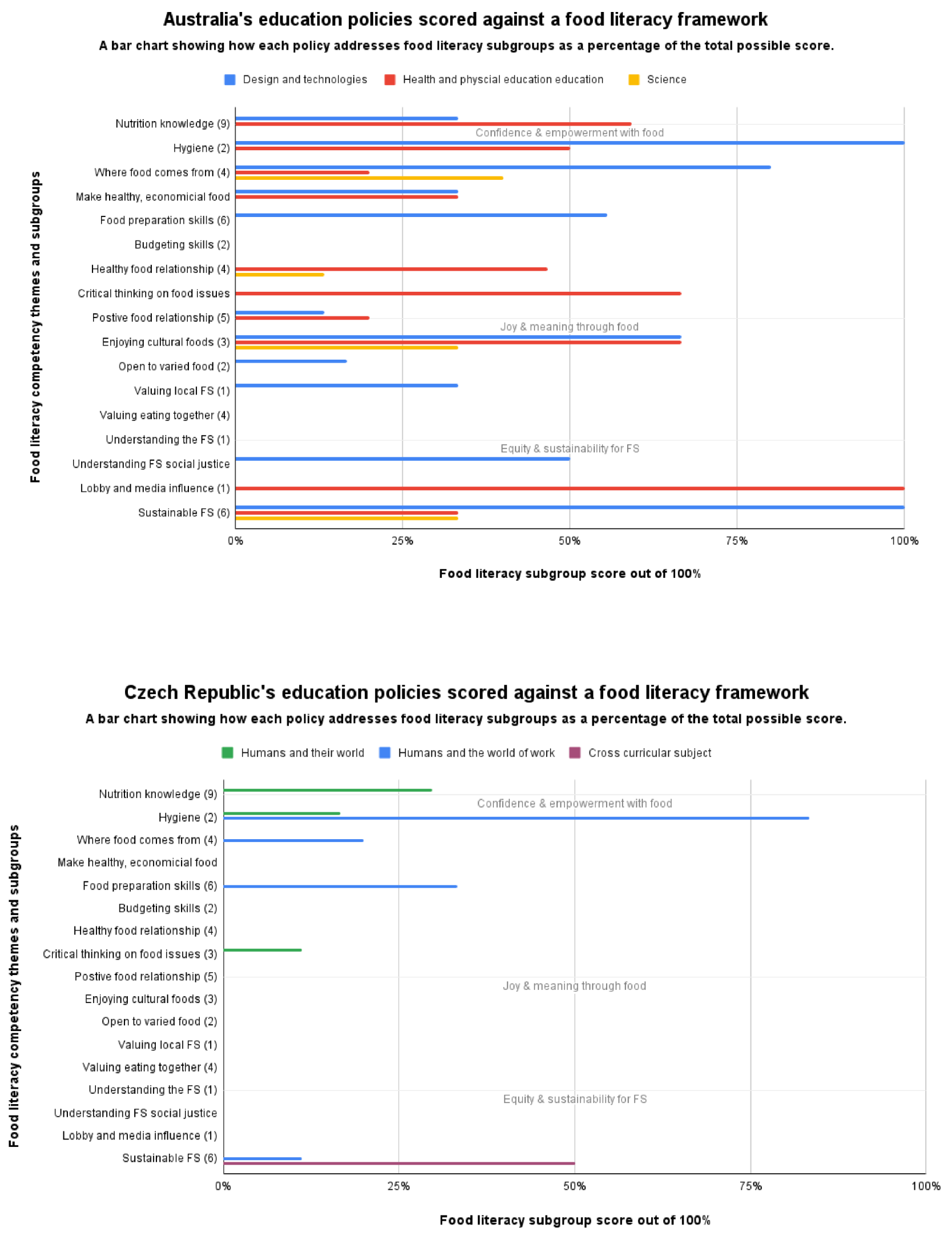
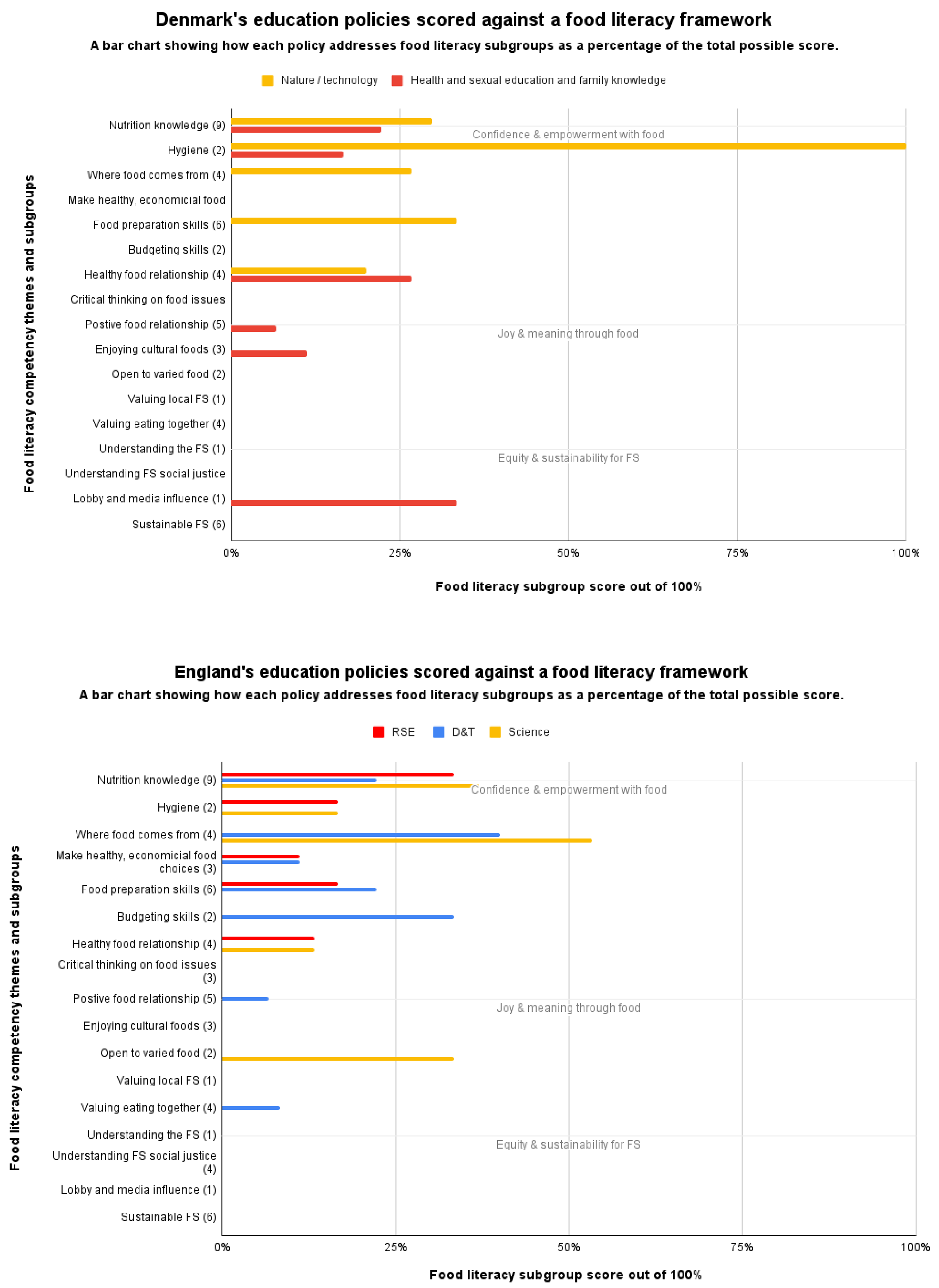
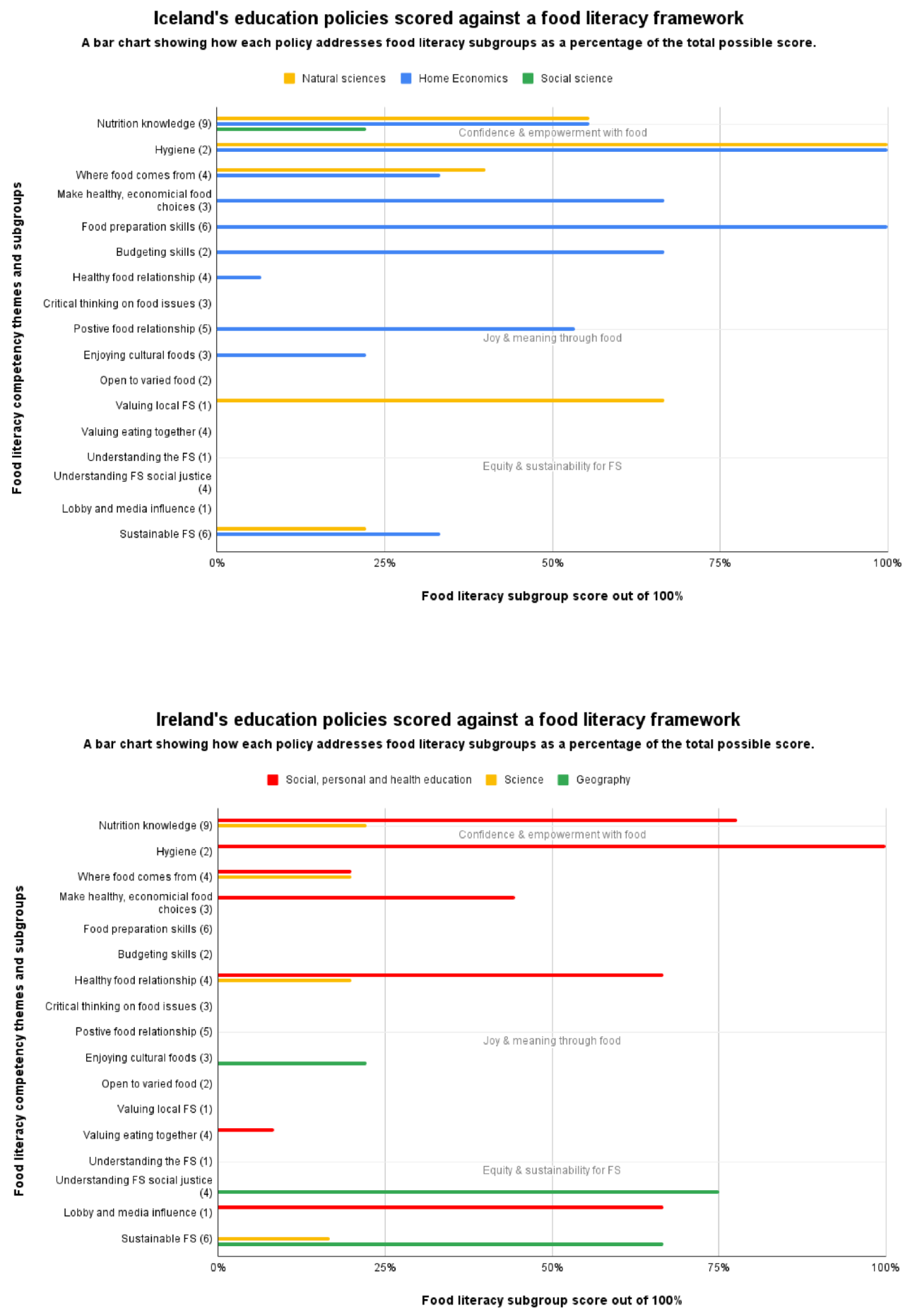
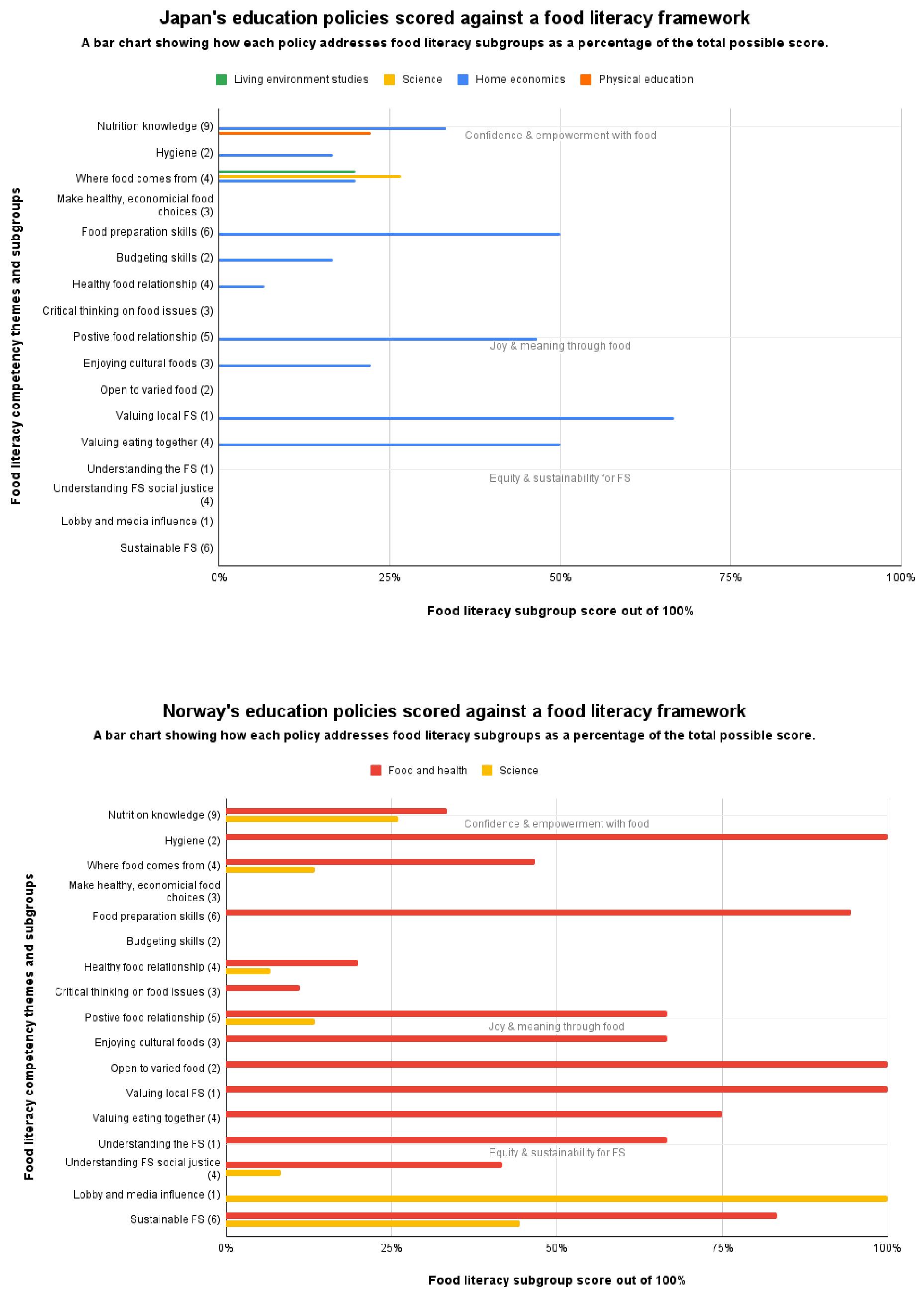
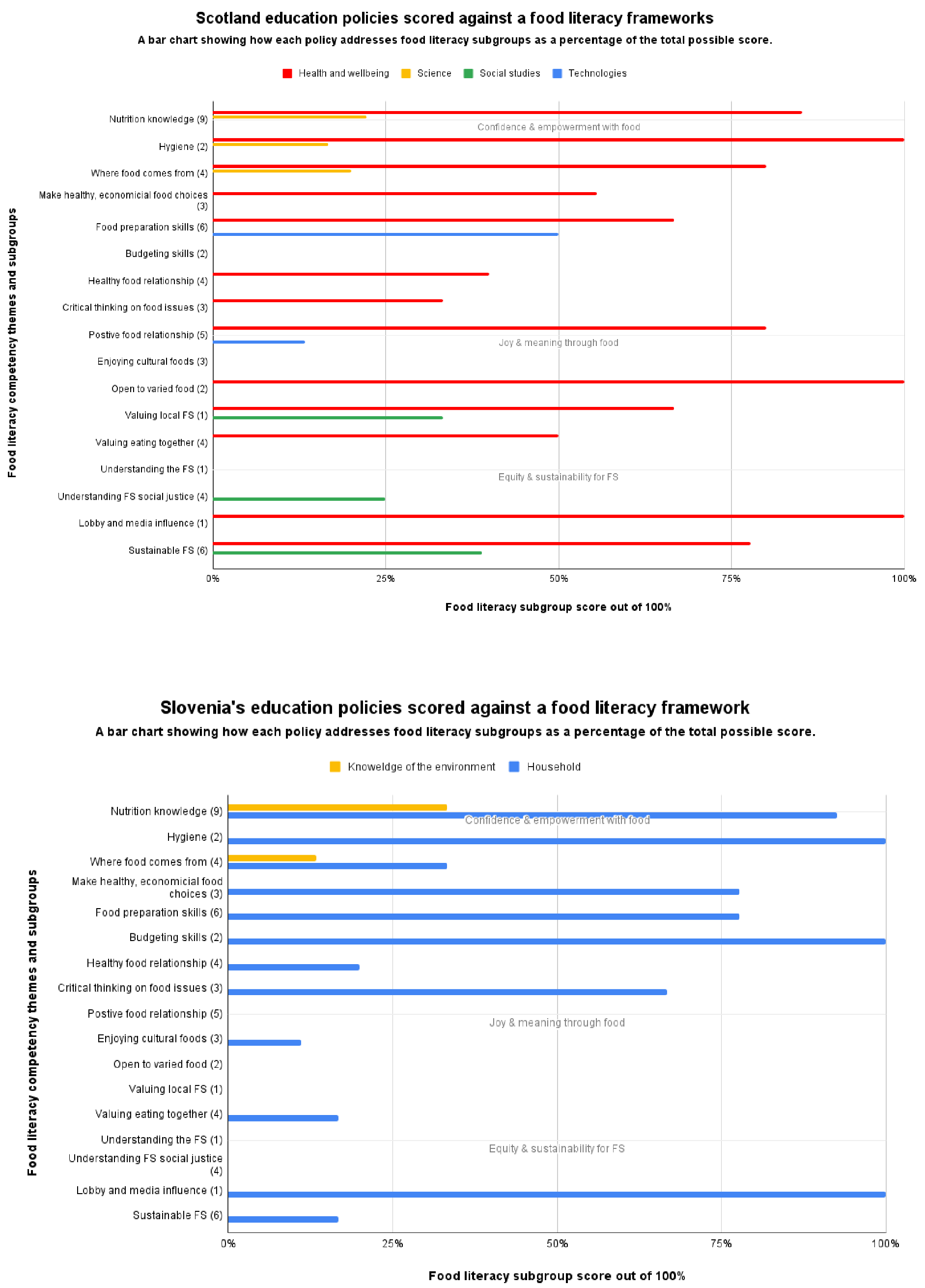
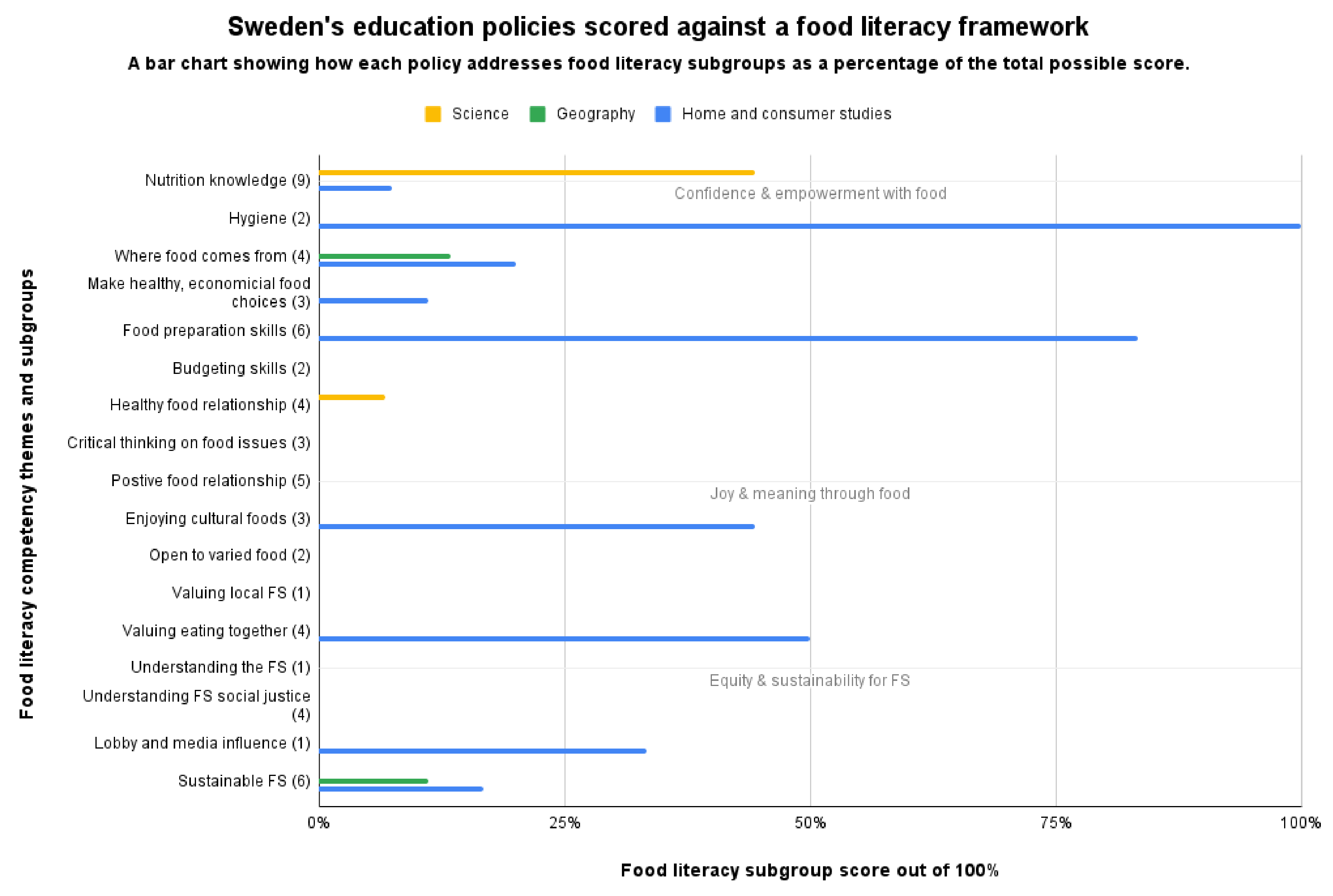
| Food Education Term | Definition |
|---|---|
| Home Economics | “at school, the study of cooking, sewing, and subjects relating to the management of a home” [18] |
| “a curriculum…to discover and further develop their own resources and capabilities to be used in their personal life, by directing their professional life, preparing them for life” [19] | |
| Food Technology | “knowledge and skills to design and make food products effectively…use the physical, chemical and nutritional properties of foods to meet a specific need…implement their design hygienically, safely and effectively. They need to evaluate the design and the product” [20] |
| Nutrition Education | “any combination of educational strategies accompanied by environmental supports, designed to facilitate voluntary adoption of food choices, and other food and nutrition-related behaviours conducive to health and wellbeing (of individuals, community, planet)” [21] |
| Food and Cooking Skills | “a wide range of skills required to feed families, including not only factors involved with the meal preparation… but also knowledge of how to plan and budget for food and organise and plan meals that other members of the household will find acceptable” [22] |
| Food Education | “Education that supports learning about food, nutrition and the role that food plays in one’s life, relationships, culture, communities, environment, and in history and society” [23] |
| Food Literacy | “the ability of an individual to understand food in a way that they develop a positive relationship with it, including food skills and practices across the lifespan in order to navigate, engage, and participate within a complex food system. It’s the ability to make decisions to support the achievement of personal health and a sustainable FS considering environmental, social, economic, cultural, and political components” [24] |
| To Be Included within the Case Study, Curriculums Must: | Justification |
|---|---|
| Have an English translation. | This is the lead author’s only language. |
| Be issued by national government departments/applied in national education systems. | Ensures a consistency across levels of governance, improving rigor and reliability. |
| Be implemented in education for 4–11-year old’s. | Research scope is primarily concerned with primary education, which determines the age range. |
| Be mandatory and currently implemented curriculum. | To make recommendations to policymakers, policies need to be from national governments where live policy implementation is mandated. |
| Include any kind of “food education”. | To establish where food education takes place, curriculums must refer to food topics. |
| Excluded scenarios | Justification |
| Nursery, pre-school, secondary and tertiary education. | Research is only concerned with primary education. |
| Policy implementation and effectiveness. | This makes the research scope too extensive. |
| School meals. | Not typically included within education policy and keeps research scope manageable. |
| How Well Does the Curriculum Address the FL Competency? | Explanation | Score |
|---|---|---|
| Comprehensively | Fully addresses the FL competency with detail. | 3 |
| Partially | Addresses the FL competency, but only in some way, lacking detail. | 2 |
| Acknowledges competency | Makes references to the competency but is vague and lacking in detail. | 1 |
| Fails | Makes no reference to the FL competency. | 0 |
| Location (Number of Curriculums That Met Inclusion Criteria) | Food Curriculum | Non-Food Curriculum | |||
|---|---|---|---|---|---|
| Practical Approach | Health Approach | Science | Other | ||
| Australia (3) | D&T | Health and Physical Education | Science | ||
| Czech Republic (3) | Humans and the World of Work | Humans and their World | Cross Curricular Subjects | ||
| Denmark (2) | Health and Sexual Education and Family Knowledge | Nature/ Technology | |||
| England (3) | D&T | Relationships and Sex Education and Health Education | Science | ||
| Iceland (3) | Home Economics | Natural Sciences | Social Science | ||
| Ireland (3) | Social, Personal and Health Education | Science | Geography | ||
| Japan (4) | Home Economics | Science | Living Environment Studies | PE | |
| Norway (2) | Curriculum in Food and Health | Science | |||
| Scotland (4) | Technologies | Health and Well Being | Science | Social Studies | |
| Slovenia (2) | Household | Knowledge of the Environment | |||
| Sweden (3) | Home and Consumer Studies | Science | Geography | ||
| Science Topics | Australia | Czech Republic | Denmark | England | Iceland | Ireland | Japan | Norway | Scotland | Slovenia | Sweden |
|---|---|---|---|---|---|---|---|---|---|---|---|
| Health | ✓ | ✓ | ✓ | ✓ | ✓ | ✓ | ✓ | ✓ | ✓ | ||
| Diet | ✓ | ✓ | ✓ | ✓ | ✓ | ✓ | ✓ | ||||
| Senses | ✓ | ✓ | ✓ | ✓ | ✓ | ✓ | ✓ | ||||
| Plants | ✓ | ✓ | ✓ | ✓ | ✓ | ✓ | ✓ | ✓ | ✓ | ✓ | ✓ |
| Animals (including humans) | ✓ | ✓ | ✓ | ||||||||
| Hygiene | ✓ | ✓ | ✓ | ✓ | ✓ | ✓ | |||||
| Nutrition | ✓ | ✓ | ✓ | ✓ | |||||||
| Local foods | ✓ | ||||||||||
| Food science | ✓ | ||||||||||
| Sustainability | ✓ | ✓ |
Publisher’s Note: MDPI stays neutral with regard to jurisdictional claims in published maps and institutional affiliations. |
© 2022 by the authors. Licensee MDPI, Basel, Switzerland. This article is an open access article distributed under the terms and conditions of the Creative Commons Attribution (CC BY) license (https://creativecommons.org/licenses/by/4.0/).
Share and Cite
Smith, K.; Wells, R.; Hawkes, C. How Primary School Curriculums in 11 Countries around the World Deliver Food Education and Address Food Literacy: A Policy Analysis. Int. J. Environ. Res. Public Health 2022, 19, 2019. https://doi.org/10.3390/ijerph19042019
Smith K, Wells R, Hawkes C. How Primary School Curriculums in 11 Countries around the World Deliver Food Education and Address Food Literacy: A Policy Analysis. International Journal of Environmental Research and Public Health. 2022; 19(4):2019. https://doi.org/10.3390/ijerph19042019
Chicago/Turabian StyleSmith, Kim, Rebecca Wells, and Corinna Hawkes. 2022. "How Primary School Curriculums in 11 Countries around the World Deliver Food Education and Address Food Literacy: A Policy Analysis" International Journal of Environmental Research and Public Health 19, no. 4: 2019. https://doi.org/10.3390/ijerph19042019
APA StyleSmith, K., Wells, R., & Hawkes, C. (2022). How Primary School Curriculums in 11 Countries around the World Deliver Food Education and Address Food Literacy: A Policy Analysis. International Journal of Environmental Research and Public Health, 19(4), 2019. https://doi.org/10.3390/ijerph19042019






